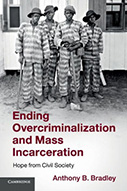Ending Overcriminalization And Mass Incarceration: Hope From Civil Society

Author: Anthony B. Bradley
Publisher: Cambridge, UK: Cambridge University Press, 2018. 230p.
Reviewer: M. Beth Valentine | March 2019
Incarceration rates are dismal. Prisons and jails are often overcrowded, sometimes holding twice their capacity. In Ending Overcriminalization and Mass Incarceration: Hope from Civil Society, Anthony Bradley examines the various causes of and possible solutions for this phenomenon. Though the topic itself isn’t new, he approaches it through a unique lens: personalism. This theme structures his analysis and provides a philosophical grounding that necessitates a focus on the individual. The result is a strong emphasis on lowering recidivism rates, and the role of civil society in reducing incarceration overall. Bradley argues that policy changes won’t be enough, and, as the title states, hope for change instead must come from the community and its institutions. Though the theoretical integration and use of empirical data is somewhat weak at times, the book represents an excellent overview of the existing problems and solutions while effectively pushing its audience to consider the inherently human aspect of this issue.
The cornerstone of the book is the theory of personalization, which Bradley borrows from Christian Smith, Thomas Rourke, and Rosita Chazarreta Rourke. Roughly and briefly, this version of personalism claims that to understand people and social relations, we must first understand personhood. In our context, this means that we must first view offenders as persons, who are agents and not merely subjects occupying space in a mechanized world. Part of understanding others as persons involves understanding human goods and needs. We then use this to understand motives, which then informs our understanding of deviance – e.g. criminal behavior. From here, we can then propose reforms that are centered on the persons and their goodness.
Though Bradley introduces this concept and returns to it at the end of his chapters, he does not offer a full defense of it. He uses personalism as support for his claim that “criminal justice reform should be centered on what is good for the person” and that we have a “moral obligation” to end mass incarceration (presumably for personalism-like reasons) (5, 4). While plausible, these claims are more assertion than conclusion. The assumption of a founding principle is not necessarily unusual, but I found it a disappointing choice here, especially given the predominance of certain theories of the aims of and justifications for punishment. While he does mention some of these in very brief passing, his treatment – especially of retribution – relies on a rather odd and unorthodox interpretation of this aim. As a result, the plausibility of adopting personalism as a lens through which to evaluate criminal justice reform relies largely on intuitive appeal. The upshot is that, if one is on board with personalism, then one will be on board for most of the rest of the book. However, if one is more critical of or agnostic about personalism, then the remainder of the book will be only selectively persuasive.
Even if one is not a personalist, there is still much in the book to find agreement on. This is, in part, because the ties with personalism are not always explicit. Though the conclusion of each chapter returns to the theme of personalism, the concept is rarely integrated into the chapter’s main discussion. A careful reader can make connections, but readers can also agree with much of the body of the chapters without adhering to the conceptual bookend. I suspect this is because personalism seems to orientate the book towards particular topics; yet someone who is concerned with reducing incarceration rates for other reasons would be drawn to the same topics. There are some normative aspects, however, that rely heavily on personalism and times where it is explicitly present and pushing towards a particular conclusion. Where the integration of personalism with the text is most successful is with the stories that Bradley uses to start the chapters. Though perhaps initially jarring to those who have a low tolerance for anecdotal evidence, the point of these narratives is, I think, not as evidence. Instead, they serve as a reminder to the reader of the person and personhood that reside behind the statistics and policies.
After establishing the conceptual framework, the book begins its largely summative exploration of the causes of mass incarceration. The first chapter covers standard ground, repeating much of what has been said regarding the existence of an expanding criminal code and a rise in incarceration. In some ways more comprehensive than the standard overview, the chapter also includes a discussion of the juvenile justice system. Bradley’s attentiveness to this aspect of the criminal justice system (motivated, I suspect, by personalism) is one area where the book stands out. The book as a whole successfully reminds the reader that the juvenile and adult systems are related through the people that occupy them, and solutions to mass incarceration must focus on both areas.
The remaining chapters focus on contributing factors to mass incarceration and possible solutions, with a recurring focus on reducing recidivism rates. The second chapter argues that prosecutorial discretion and plea bargaining contribute to increasing prison and jail populations. True to personalism, it also looks at the incentives or motives that lead to prosecutorial overreach. The proposed solutions, which are largely a summary of others’ suggestions, focus on restructuring this incentive structure, increasing accountability, and encouraging prosecutors to stress sentencing alternatives. Though many of the claims made are plausible, additional empirical evidence is needed.
In contrast with prosecutorial discretion, the third chapter looks favorably upon judicial discretion, urging a reduction in mandatory minimums and greater freedom in juvenile sentencing. While this chapter ignores the fact that some elected judges have incentives similar to those of the prosecutors in the previous chapter, it presents judges as in a unique position “to provide defendants with the help they need to stop committing crimes” (70). Here the reader finds not only the focus on keeping those who have served their time from returning to incarceration, but also a focus on doing what is best for the offender. While this would presumably reduce crime rates, it does not sit comfortably with other perspectives that hold to the belief that the legal system owes it to victims to punish their offenders.
The third chapter returns to common ground, noting the problems associated with wealth disparity and its correlation with minority status. The author presents a survey of policy solutions to this issue, going beyond mere funding increases for public defenders to innovate frameworks that rely on ideas like consumer sovereignty. Most importantly, he argues that there must be a change in perception and attitude as well. The solution here is not just with policy, but with people.
The fourth chapter focuses on the school-to-prison pipeline. Bradley provides a fairly comprehensive picture of how education reform, specifically as it relates to school discipline policies, could reduce incarceration rates. Disproportionate punishments, zero tolerance policies, and officers in school lead not only to higher drop-out rates, but also an increase in referral to the legal system for infractions that previously would have been handled by school administrators. As with the inequalities of legal defense, the numbers here are disproportionally skewed towards minorities, including children with disabilities. While one could care about education reform simply because it would reduce incarceration rates, Bradley – at the chapter’s close – once again urges the reader to care not just about numbers, but about the whole person.
This theme is brought to the forefront in the next chapter, where he explores the social and economic costs of our current incarceration rates, for those imprisoned and their families.
I suspect that some of the items listed as a cost of incarceration are also a cause, meaning that there may be yet other concurrent causes for the negative costs that won’t go away once incarceration rates are decreased. This chapter most of all exemplifies the personalist approach. Bradley focuses on the whole person – on their whole life – and not merely that portion immediately surrounding their incarceration. For example, he focuses on the negative affects of single-parent households, lack of a father figure, and low marriage rates (at times arguably confusing correlation with causation and being slightly heteronormative). Expanding the focus, he reminds readers of the full impact of incarceration by drawing our attention to post-traumatic stress and other mental health issues affecting individuals during and after incarceration. All of these matters intersect with economic insecurity, which is made worse by the discrimination convicted offenders often face in pursuing employment.
As the title indicates, the hope for alleviating these costs comes from civil society and civic engagement. Though chapter seven provides an overview of some legislative proposals at the state level, the final chapter focuses on areas where there is no legislative solution, namely civil society. Throughout the final chapters, Bradley asserts the importance of civic engagement, contrasting this importance with the ways in which engagement is often cut off from those who are and were incarcerated. The final chapter is dedicated to highlighting some civil-society programs that operate during incarceration and after release to integrate offenders into their community and give them resources for a successful reentry.
Ending on a somewhat idealistic note, the author pushes the emphasis on personalism and civil society even further: “the most powerful weapon and deterrent against deviance and criminal activity is love” (211). Though sounding a bit like a cliché – and somewhat like a Beatle’s song – it seems to be the natural conclusion of a focus on personhood.
Overall, Ending Overcriminalization and Mass Incarceration is a good introduction to the issue of mass incarceration. Bradley has provided a solid compilation and overview of existing solutions to this problem while adding a unique lens through which to view the topic. While there are some shortcomings, the book challenges readers to focus on the person affected by not just the policies but the civil society that surrounds them.
Beth Valentine, Assistant Professor University of North Dakota


